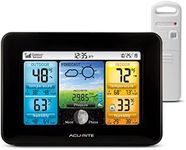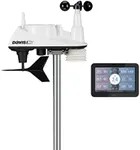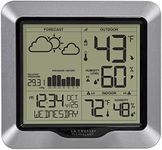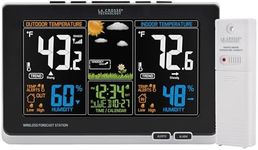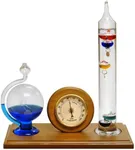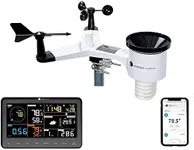Buying Guide for the Best Digital Weather Stations
Choosing the right digital weather station can greatly enhance your ability to monitor and understand the weather conditions in your area. Whether you're a weather enthusiast, a gardener, or just someone who likes to stay informed, a digital weather station can provide you with valuable data. To make the best choice, it's important to understand the key specifications and how they align with your needs.SensorsSensors are the components that measure various weather parameters such as temperature, humidity, wind speed, and rainfall. The quality and number of sensors determine the accuracy and range of data you can collect. Basic models may only measure temperature and humidity, which is sufficient for indoor use or casual monitoring. More advanced models include additional sensors for wind speed, direction, rainfall, and even UV levels, making them ideal for outdoor enthusiasts or those needing detailed weather data for gardening or farming.
AccuracyAccuracy refers to how close the measurements from the weather station are to the actual weather conditions. This is crucial for reliable data. Basic models may have a higher margin of error, which is acceptable for general use. However, if precise data is important for your activities, such as in scientific research or agriculture, look for models with higher accuracy ratings. Manufacturers often provide accuracy specifications, so compare these to ensure you get the level of precision you need.
DisplayThe display is where you view the data collected by the weather station. It can range from simple LCD screens to more advanced color displays with graphical representations of the data. A basic display might be sufficient if you only need to check the temperature and humidity occasionally. For more detailed monitoring, a larger, more advanced display that shows multiple data points simultaneously and in an easy-to-read format can be very beneficial.
ConnectivityConnectivity options determine how you can access and share the data from your weather station. Basic models might only offer a local display, while more advanced models can connect to your home Wi-Fi network, allowing you to access data remotely via a smartphone app or computer. Some models also integrate with smart home systems or provide data to online weather services. If you want to monitor weather conditions while away from home or share data with a community, look for models with robust connectivity features.
Power SourceThe power source for a digital weather station can be batteries, solar power, or an AC adapter. Battery-powered models offer flexibility in placement but require regular battery changes. Solar-powered models are more sustainable and can be placed outdoors without worrying about power outlets, but they need sufficient sunlight to function effectively. Models with an AC adapter provide continuous power but need to be placed near an outlet. Choose the power source that best fits your intended placement and maintenance preferences.
Data Logging and StorageData logging and storage capabilities allow you to record and review historical weather data. Basic models may only display current conditions without storing past data. More advanced models can log data over time, providing valuable insights into weather patterns and trends. This feature is particularly useful for scientific research, farming, or any application where understanding long-term weather changes is important. Consider how much historical data you need to store and how you plan to use it when choosing a model.
Durability and Build QualityDurability and build quality are important, especially if the weather station will be placed outdoors. Look for models with weather-resistant materials that can withstand harsh conditions such as rain, snow, and extreme temperatures. A well-built weather station will last longer and provide more reliable data over time. If you live in an area with severe weather, investing in a durable model is essential to ensure continuous operation and accurate data collection.


